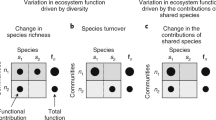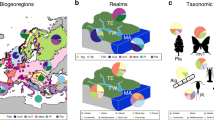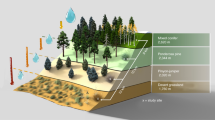Abstract
Patterns in the spatial distribution of organisms provide important information about mechanisms that regulate the diversity of life and the complexity of ecosystems1,2. Although microorganisms may comprise much of the Earth's biodiversity3,4 and have critical roles in biogeochemistry and ecosystem functioning5,6,7, little is known about their spatial diversification. Here we present quantitative estimates of microbial community turnover at local and regional scales using the largest spatially explicit microbial diversity data set available (> 106 sample pairs). Turnover rates were small across large geographical distances, of similar magnitude when measured within distinct habitats, and did not increase going from one vegetation type to another. The taxa–area relationship of these terrestrial microbial eukaryotes was relatively flat (slope z = 0.074) and consistent with those reported in aquatic habitats8,9. This suggests that despite high local diversity, microorganisms may have only moderate regional diversity. We show how turnover patterns can be used to project taxa–area relationships up to whole continents. Taxa dissimilarities across continents and between them would strengthen these projections. Such data do not yet exist, but would be feasible to collect.
This is a preview of subscription content, access via your institution
Access options
Subscribe to this journal
Receive 51 print issues and online access
$199.00 per year
only $3.90 per issue
Buy this article
- Purchase on Springer Link
- Instant access to full article PDF
Prices may be subject to local taxes which are calculated during checkout


Similar content being viewed by others
References
Brown, J. H. et al. The fractal nature of nature: power-laws, ecological complexity and biodiversity. Phil. Trans. R. Soc. Lond. B 357, 619–626 (2002)
Levin, S. The problem of pattern and scale in ecology. Ecology 73, 1943–1967 (1992)
Torsvik, V., Øvreås, L. & Thingstad, T. F. Prokaryotic diversity—magnitude, dynamics, and controlling factors. Science 296, 1064–1066 (2002)
Venter, J. C. et al. Environmental genome shotgun sequencing of the Sargasso Sea. Science 304, 66–74 (2004)
Wardle, D. A. in Communities and Ecosystems: Linking Aboveground and Belowground Components (eds Levin, S. A. & Horn, H. S.) (Princeton Univ. Press, Princeton, 2002)
Balser, T. C., Kinzig, A. P. & Firestone, M. K. in The Functional Consequences of Biodiversity (eds Kinzig, A. P., Pacala, S. W. & Tilman, D.) 265–293 (Princeton Univ. Press, Princeton, 2001)
Morin, P. J. & McGrady-Steed, J. Biodiversity and ecosystem functioning in aquatic microbial systems: a new analysis of temporal variation and species richness-predictability relations. Oikos 104, 458–466 (2004)
Finlay, B. J. Global dispersal of free-living microbial eukaryote species. Science 296, 1061–1063 (2002)
Azovksy, A. I. Size-dependent species-area relationships in benthos: is the world more diverse for microbes? Ecography 25, 273–282 (2002)
Whittaker, R. H. Vegetation of the Siskiyou Mountains, Oregon and California. Ecol. Monogr. 30, 279–338 (1960)
Condit, R. et al. Beta-diversity in tropical forest trees. Science 295, 666–669 (2002)
Harrison, S. How natural habitat patchiness affects the distribution of diversity in Californian serpentine chaparral. Ecology 78, 1898–1906 (1997)
Nekola, J. C. & White, P. S. The distance decay of similarity in biogeography and ecology. J. Biogeogr. 26, 867–878 (1999)
Schluter, D. & Ricklefs, R. E. in Species Diversity in Ecological Communities (eds Ricklefs, R. E. & Schluter, D.) 1–12 (Univ. Chicago Press, Chicago, 1993)
Ettema, C. H. & Wardle, D. A. Spatial soil ecology. Trends Ecol. Evol. 17, 177–183 (2002)
Callaway, R. M., Thelen, G. C., Rodriguez, A. & Holben, W. E. Soil biota and exotic plant invasion. Nature 427, 731–733 (2004)
Horner-Devine, M. C., Carney, K. M. & Bohannan, B. J. M. An ecological perspective on bacterial biodiversity. Phil. Trans. R. Soc. Lond. B 271, 113–122 (2004)
Ward, D. M., Ferris, M. J., Nold, S. C. & Bateson, M. M. A natural view of microbial biodiversity within hot spring cyanobacterial mat communities. Microbiol. Mol. Biol. Rev. 62, 1353–1370 (1998)
Poulin, R. The decay of similarity with geographical distance in parasite communities of vertebrate hosts. J. Biogeogr. 30, 1609–1615 (2003)
Legendre, P. & Legendre, L. Numerical Ecology (Elsevier, Boston, 1998)
Harte, J., McCarthy, S., Taylor, K., Kinzig, A. & Fischer, M. L. Estimating species-area relationships from plot to landscape scale using species spatial-turnover data. Oikos 86, 45–54 (1999)
Ranjard, L. et al. Characterization of bacterial and fungal soil communities by automated ribosomal intergenic spacer analysis fingerprints: biological and methodological variability. Appl. Environ. Microbiol. 67, 4479–4487 (2001)
Kent, A. D. & Triplett, E. W. Microbial communities and their interactions in soil and rhizosphere ecosystems. Annu. Rev. Microbiol. 56, 211–236 (2002)
Øvreås, L. Population and community level approaches for analysing microbial diversity in natural environments. Ecol. Lett. 3, 236–251 (2000)
Finlay, B. J., Esteban, G. V. & Fenchel, T. Protozoan diversity: converging estimates of the global number of free-living ciliate species. Protist 149, 29–37 (1998)
Oliver, I. et al. Land systems as surrogates for biodiversity in conservation planning. Ecol. Appl. 14, 485–503 (2004)
Yeates, C. & Gillings, M. Rapid purification of DNA from soil for molecular biodiversity analysis. Lett. Appl. Microbiol. 27, 49–53 (1998)
Manly, B. F. J. Randomization, Bootstrap and Monte Carlo Methods in Biology (Chapman & Hall/CRC, New York, 1997)
Oden, N. L. & Sokal, R. R. An investigation of three-matrix permutation tests. J. Classif. 9, 275–290 (1992)
Legendre, P. Comparison of permutation methods for the partial correlation and partial Mantel tests. J. Stat. Comput. Sim. 67, 37–73 (2000)
Acknowledgements
We thank F. Ayala, E. Berlow, B. Bohannan, R. Condit, J. Harte, A. Hastings, C. Horner-Devine, J. Hughes, N. Martinez and I. Wright for comments on the manuscript, and U. Malvadkar, M. Holyoak and B. Melbourne for discussions. The authors are grateful to M. Holley and M. Raison for technical assistance with the ARISA analyses. The project was funded by the Australian Research Council and the Resource and Conservation Assessment Council of the NSW Government. J.L.G. acknowledges the NSF Postdoctoral Fellowship Program in Biological Informatics for financial support.Authors' contributions All authors contributed intellectual input to the project. The original concept, sample design and collections were carried out by A.J.H., M.W., I.O., D.B., M.D., M.G. and A.J.B. The first three authors (J.L.G., A.J.H. and M.W.) took the lead in the analysis and writing up of this work.
Author information
Authors and Affiliations
Corresponding author
Ethics declarations
Competing interests
The authors declare that they have no competing financial interests.
Supplementary information
Supplementary Figure 1
Photographs of the four land systems sampled in Sturt National Park. (PDF 200 kb)
Supplementary Figure 2
Diagram illustrating the sampling scheme within Sturt National Park. (PDF 258 kb)
Supplementary Methods
Details of automated rRNA intergenic spacer analysis (ARISA) molecular techniques. (DOC 39 kb)
Rights and permissions
About this article
Cite this article
Green, J., Holmes, A., Westoby, M. et al. Spatial scaling of microbial eukaryote diversity. Nature 432, 747–750 (2004). https://doi.org/10.1038/nature03034
Received:
Accepted:
Issue Date:
DOI: https://doi.org/10.1038/nature03034
This article is cited by
-
Dynamic Changes of Soil Microbial Communities During the Afforestation of Pinus Armandii in a Karst Region of Southwest China
Microbial Ecology (2024)
-
Seasonal variation and human impacts of the river biofilm bacterial communities in the Shiting River in southeastern China
Environmental Monitoring and Assessment (2024)
-
Cryophilic Tardigrada have disjunct and bipolar distribution and establish long-term stable, low-density demes
Polar Biology (2023)
-
Effect of prescribed burning on the small-scale spatial heterogeneity of soil microbial biomass in Pinus koraiensis and Quercus mongolica forests of China
Journal of Forestry Research (2023)
-
Differences in distributions, assembly mechanisms, and putative interactions of AOB and NOB at a large spatial scale
Frontiers of Environmental Science & Engineering (2023)
Comments
By submitting a comment you agree to abide by our Terms and Community Guidelines. If you find something abusive or that does not comply with our terms or guidelines please flag it as inappropriate.



